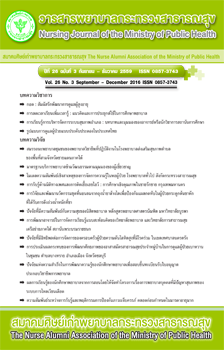รูปแบบการดูแลผู้ป่วยแบบประคับประคองในประเทศไทย
Main Article Content
Abstract
บทคัดย่อ
อุบัติการณ์ของโรคเรื้อรัง โรคร้ายแรงและโรคที่คุกคามต่อชีวิต ที่มีจำนวนที่เพิ่มสูงขึ้น ส่งผลให้ความต้องการดูแลผู้ป่วยในระยะท้ายของชีวิตทวีความสำคัญมากขึ้นเรื่อยๆ องค์การอนามัยโลกได้ประกาศให้ระบบบริการสุขภาพต้องบูรณาการการดูแลแบบประคับประคองเข้าไปเป็นส่วนหนึ่งในการรักษาตลอดช่วงชีวิต มีความพยายามจัดการดูแลแบบประคับประคองขึ้นทั้งในสถานพยาบาลและชุมชนในหลากหลายรูปแบบ บทความนี้จึงจัดทำขึ้นโดยมีวัตถุประสงค์เพื่อวิเคราะห์ รูปแบบการดูแลแบบประคับประคอง 4 รูปแบบในประเทศไทย: การดูแลที่ดำเนินการโดยองค์กรทางศาสนา การดูแลที่บ้าน/การดูแลโดยชุมชน การดูแลในโรงพยาบาล และการดูแลโดยสถานพยาบาลกึ่งบ้าน รวมทั้งจุดแข็ง ข้อจำกัดของแต่ละรูปแบบ เพื่อเป็นข้อมูลพื้นฐานในการพัฒนาระบบการดูแลแบบประคับประคองต่อไป
Palliative Care Model in Thailand
Piyawan Pokpalagon*
Abstract
The emergence of chronic diseases and life-threatening disease leads to the necessity of healthcare provision for people who are at the terminal phase of life. The World Health Organization emphasizes that palliative care should be integrated into the maintenance of the life span. Most organizations have tried to incorporate palliative care in hospitals and in the community in various forms. Therefore, this article aims to analyze the four palliative care delivery models in Thailand: palliative care operated by religious-based organizations, home-based/community-based care, hospital-based services, and hospice. The strengths and limitations of each palliative care model are discussed and recommendations for further development of palliative care models are also proposed.
Article Details
บทความและรายงานวิจัยในวารสารพยาบาลกระทรวงสาธารณสุข เป็นความคิดเห็นของ ผู้เขียน มิใช่ของคณะผู้จัดทำ และมิใช่ความรับผิดชอบของสมาคมศิษย์เก่าพยาบาลกระทรวงสาธารณสุข ซึ่งสามารถนำไปอ้างอิงได้

